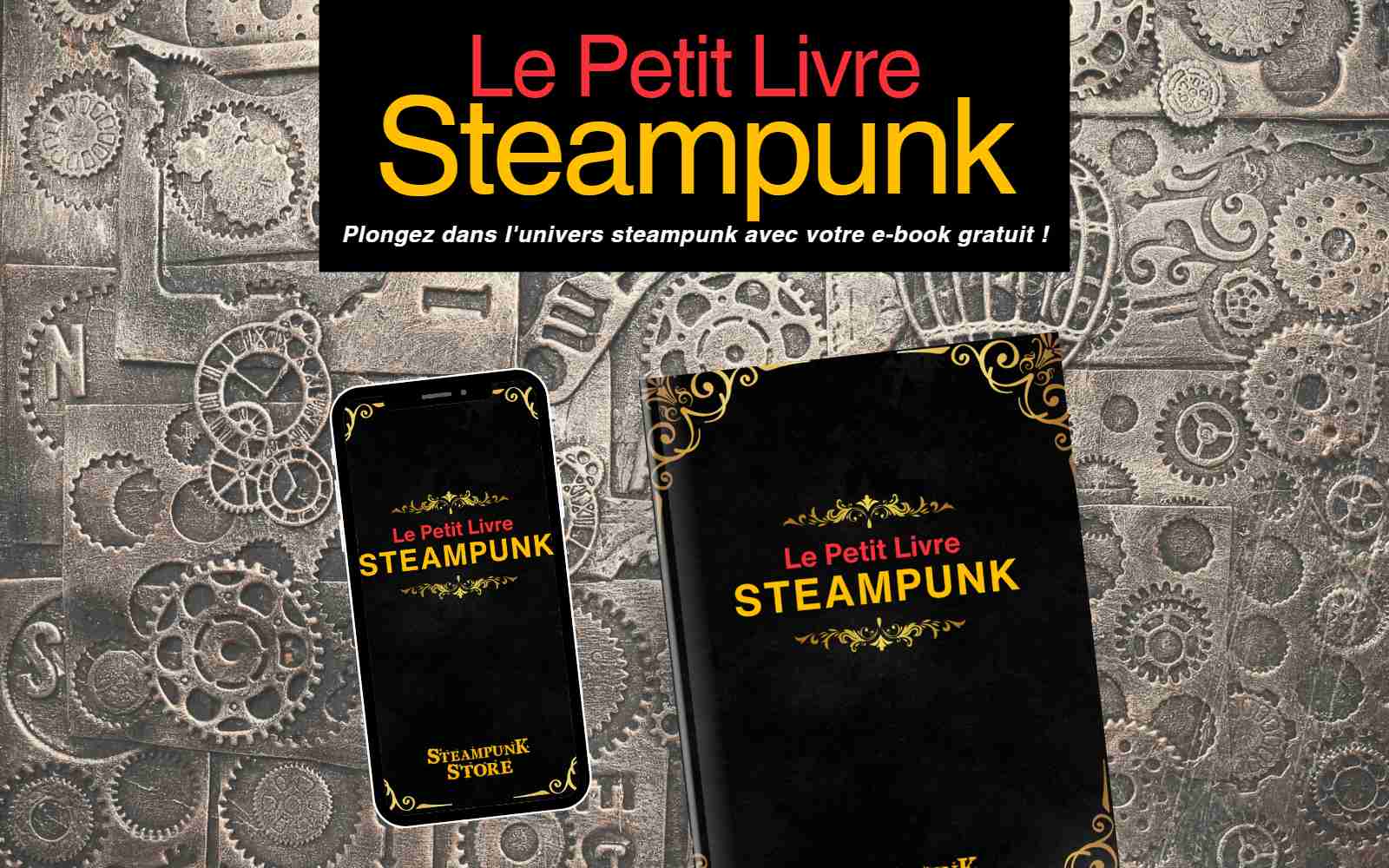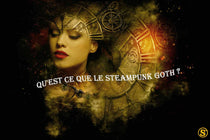
The Intellectual Genesis and Philosophical Foundations of Steampunk Aesthetics
The steampunk movement emerged in the twilight of the 20th century as a sophisticated subgenre of speculative fiction, embodying what Michel Foucault might have termed a "counter-memory" of technological development. This aesthetic paradigm draws its conceptual framework from the Victorian era and the Belle Époque, that pivotal moment when the Industrial Revolution transformed not merely the means of production, but the very fabric of human consciousness and social organization.
This literary and artistic movement orchestrates a compelling synthesis of historical authenticity, speculative technology, and fantastical imagination to construct what we might call a "retrofuturistic hermeneutics" — a unique interpretive framework for understanding the relationship between technological possibility and cultural memory.
Defining the Steampunk Paradigm
Steampunk represents a sophisticated aesthetic and philosophical movement that reimagines the Victorian era through the lens of alternative technological development. At its core, it explores the counterfactual proposition: what if steam technology had continued its evolutionary trajectory rather than being superseded by electricity and internal combustion? This speculative premise generates not merely stylistic choices, but an entire epistemological framework for understanding technological progress, social organization, and cultural possibility.
The Literary Archaeology of Steam-Powered Imagination
The intellectual genealogy of steampunk traces its origins to the visionary works of Jules Verne and H.G. Wells, those prophetic architects of scientific romance who intuited the profound implications of steam-powered technology. These authors constructed elaborate uchronias — alternative historical timelines — that merged empirical observation with speculative extrapolation, creating what we now recognize as the foundational texts of retrofuturistic literature.
The term "steampunk" itself was coined in 1987 by science fiction author K.W. Jeter, who sought to categorize the works of Tim Powers, James Blaylock, and his own literary productions. These narratives synthesized science fiction methodology with retrofuturistic aesthetics, drawing particular inspiration from the British Empire's technological grandeur and social complexity during its Victorian zenith.
Essential Coordinates of the Steampunk Universe
💡 Literary Archaeology: Steampunk excavates its inspiration from the visionary works of Jules Verne and H.G. Wells, constructing alternative technological trajectories.
💡 Industrial Sublime: Characterized by steam engines, precision gears, and materials such as leather and brass that embody tactile authenticity.
💡 Victorian Sartorial Grammar: Corsets and bustles for women; frock coats and bowler hats for gentlemen, creating a distinctive visual vocabulary.
💡 Mechanical Ornamentation: Round spectacles, pocket watches, and mechanically-inspired jewelry function as both aesthetic and symbolic elements.
💡 Cultural Transmutation: Present across literature, cinema, music, and interactive media, steampunk operates as a transdisciplinary phenomenon.
💡 Architectural Innovation: Utilization of exposed metal beams, brick masonry, and mechanical detailing that celebrates industrial craftsmanship.
💡 Ecological Consciousness: Advocates for recycling and upcycling of vintage materials, embodying sustainable aesthetic practices.
💡 Do-It-Yourself Ethos: Encouragement of handcrafted steampunk accessories and garments, celebrating artisanal production.
💡 Global Resonance: Style appreciated worldwide, transcending its Anglo-Saxon cultural origins to become a universal aesthetic language.
💡 Quotidian Integration: Can be incorporated into daily life through carefully selected accessories and functional objects.
The Mechanical Sublime: Aesthetic Characteristics of Industrial Romanticism

The Grammar of Industrial Aesthetics
Steampunk articulates what Edmund Burke would have recognized as a "mechanical sublime" — an aesthetic category that finds transcendence in the marriage of human ingenuity and mechanical precision. The visual vocabulary of this movement privileges gears, cogs, and steam engines not merely as decorative elements, but as symbols of a particular relationship between humanity and technology. The materials of choice — leather, brass, and aged wood — embody what Walter Benjamin might have called the "aura" of authentic craftsmanship in an age of mechanical reproduction.
The color palette of steampunk deliberately constrains itself to earth tones — browns, blacks, and deep crimsons — that evoke the natural materials and industrial processes of the Victorian era. This chromatic discipline reflects not aesthetic limitation but philosophical commitment to historical authenticity and material honesty.
Architectural Hermeneutics: The Built Environment as Cultural Text
Steampunk architecture and design constitute what Michel Foucault termed "heterotopias" — spaces that exist outside conventional temporal and spatial categories. Drawing inspiration from 19th-century industrial structures and Victorian ornamentation, this architectural philosophy celebrates the aesthetic potential of functional design while maintaining reverence for artisanal craftsmanship.

Characteristic elements include exposed metal framework, spiral staircases that function as sculptural elements, red brick masonry that speaks to industrial heritage, and weathered hardwood flooring that bears the patina of authentic use. Steampunk designers privilege furniture and decorative objects embellished with mechanical details such as gears, cogs, and visible piping systems that celebrate rather than conceal their functional components.
This design philosophy embodies an optimistic vision of technological integration, one that views machines not as alienating forces but as extensions of human creativity and ingenuity. It represents a profound critique of our contemporary tendency to black-box technology, instead advocating for transparent, comprehensible, and beautiful mechanical systems.
Sartorial Semiotics: The Language of Steampunk Fashion

Steampunk clothing for women operates as a sophisticated semiotic system that communicates complex relationships between past and future, constraint and liberation, tradition and innovation. The Victorian silhouette — with its emphasis on corsets, full skirts, and elaborately structured garments — serves not as historical reenactment but as creative reinterpretation of period aesthetics through contemporary sensibilities.
Accessories function as both practical and symbolic elements: goggles suggest protection from industrial environments while serving as metaphors for enhanced vision and technological augmentation. Pocket watches and mechanical jewelry embody the steampunk fascination with visible, comprehensible technology that maintains human scale and artisanal quality.
The Feminine Dimension of Mechanical Aesthetics

Women's steampunk fashion presents a fascinating dialectical relationship between Victorian propriety and contemporary agency. The fundamental components of the feminine steampunk wardrobe include corsets that function not as restrictive undergarments but as empowering outer wear, bustled skirts that suggest both historical continuity and practical adaptation, and military-inspired jackets that blend masculine authority with feminine elegance.
The Steampunk Dress as Cultural Artifact
The steampunk dress represents a complex negotiation between historical reference and contemporary interpretation. Typically featuring fitted bodices that emphasize natural silhouettes rather than artificial restriction, these garments often incorporate lace trim and ribbon detailing that speaks to artisanal craftsmanship. The integration of corsetry as visible structural element rather than hidden foundation represents a fundamental reimagining of the relationship between form and function.
The aesthetic occasionally incorporates gothic and punk influences, creating hybrid forms that reflect the rebellious spirit common to all three movements while maintaining distinct visual and philosophical characteristics.
Masculine Elegance: The Steampunk Gentleman

Men's steampunk clothing draws heavily upon the figure of the Victorian dandy — that paradigmatic character who embodied the intersection of aesthetic refinement and social commentary. The masculine steampunk wardrobe typically features complete suits with ruffled shirts, striped trousers, and carefully coordinated accessories that speak to both social status and individual creativity.
The Dandy as Steampunk Archetype
The dandy represents more than mere fashion choice; he embodies a particular philosophical stance toward the relationship between personal presentation and social critique. This figure — elegant, refined, sporting complete suits, bowler hats, walking canes, and pocket watches — represents the steampunk ideal of the individual who masters both aesthetic and mechanical domains.
Gothic-Steampunk Synthesis: Dark Romanticism
The integration of steampunk with gothic aesthetics creates compelling hybrid forms that explore darker themes of technological anxiety and romantic rebellion. This synthesis employs dark colors and mysterious accessories to create looks that speak to both the optimism of mechanical progress and the shadow concerns about technological alienation.
The Mechanics of Ornamentation: Steampunk Accessories

Steampunk accessories function as material philosophy, embodying the movement's core principles in tangible, wearable form. These elements serve dual purposes: they complete the aesthetic ensemble while functioning as symbols of the steampunk worldview that privileges visible, comprehensible, and beautiful technology.
Devotees of the style often engage in what we might call "technological bricolage" — creating their own accessories such as pocket watches and futuristic gadgets that blur the boundaries between functional objects and artistic statements.
-
Steampunk headwear often features mechanical embellishments and gear systems that suggest both protective function and aesthetic elaboration. Options range from the gentleman's top hat and bowler hat to the deerstalker — that iconic cap with ear flaps immortalized by Sherlock Holmes and representing the intersection of practical functionality and distinctive style.
-
Steampunk goggles typically feature round lenses surrounded by brass fittings, rivets, and mechanical details. These protective eyewear pieces can serve both corrective vision needs and pure aesthetic enhancement, functioning as perhaps the most immediately recognizable symbols of steampunk identity.
-
Steampunk jewelry draws inspiration from Victorian aesthetics while incorporating mechanical elements that speak to the movement's technological fascinations. Pocket watches, ornate brooches, and brass earrings exemplify this synthesis of period elegance and industrial imagery.
Cultural Transmissions: Steampunk Across Media
The canonical works of steampunk literature include "The Difference Engine" by William Gibson and Bruce Sterling, which explores alternative histories of computational development, "The League of Extraordinary Gentlemen" by Alan Moore and Kevin O'Neill in the comics medium, and "The Anubis Gates" by Tim Powers, which masterfully blends historical research with speculative extrapolation.
Cinematic steampunk finds expression in films such as "Howl's Moving Castle" by Hayao Miyazaki, which creates a fully realized steampunk world with profound ecological and social themes, "The City of Lost Children" by Jean-Pierre Jeunet and Marc Caro, which presents steampunk aesthetics within a darker, more surreal narrative framework, and "Wild Wild West" by Barry Sonnenfeld, which attempts to transplant steampunk sensibilities into the American Western genre.
Sonic Landscapes: The Auditory Dimension of Steampunk
The steampunk musical movement has attracted artists and ensembles such as Abney Park, Steam Powered Giraffe, and The Cog is Dead, who have developed a distinctive musical genre combining industrial sounds, traditional instrumentation, and haunting melodies that evoke both nostalgic longing and futuristic possibility.
Interactive Narratives: Steampunk in Digital Media
The video game industry has embraced steampunk aesthetics in titles such as "BioShock Infinite," "Dishonored," and "Syberia," which utilize this retrofuturistic universe to create immersive gaming experiences that explore themes of social control, technological ethics, and alternative historical development.
Young Adult Literature: Steampunk for Emerging Readers
Steampunk has found particular resonance among young adult readers through works such as Scott Westerfeld's "Leviathan" series, which reimagines World War I through steampunk sensibilities, and other titles that invite teenage and young adult readers to explore this rich literary and cultural territory.
Social Philosophy and Political Implications

The steampunk movement transcends mere aesthetic choice to engage with fundamental questions of technological development, social organization, and environmental responsibility. By proposing alternative visions of the past, steampunk enables critical examination of our contemporary moment and addresses themes such as technological progress, ecological sustainability, and power relations within industrial societies.
Ecological Ethics and Sustainable Aesthetics
Steampunk practitioners often embrace what we might term "upcycling philosophy" — the ethical imperative to transform discarded materials into objects of beauty and function. This eco-responsible approach contributes to environmental preservation while embodying the steampunk principle that discarded objects possess latent aesthetic and functional potential requiring only creative vision to realize.
The DIY Imperative: Artisanal Production in the Digital Age
For those seeking to engage in steampunk creation, the Do-It-Yourself movement offers extensive possibilities for personal expression and skill development. Online tutorials and workshops provide instruction in crafting personalized clothing and decorative objects, utilizing varied techniques accessible to practitioners at all skill levels.
DIY steampunk decoration involves the transformation of found objects and materials into steampunk lighting and other functional items, exemplifying the movement's commitment to creative reuse and individual artisanship.
Quotidian Steampunk: Integrating Retrofuturistic Aesthetics into Contemporary Life

Steampunk style, while rooted in artistic and cultural expression, can be thoughtfully integrated into contemporary daily life to provide distinctive touches of retrofuturistic elegance and intellectual sophistication. Consider these approaches to everyday steampunk integration:
-
Personal accessories: Pocket watches, aviator or protective goggles, and gear-inspired jewelry can add unique and sophisticated elements to contemporary outfits while reflecting the wearer's engagement with steampunk philosophy and aesthetics.
-
Functional objects: Many everyday items can be adapted to steampunk aesthetic principles. For more discreet integration, one might avoid the full top hat while incorporating elements such as vintage-styled eyewear, mechanical jewelry, or period-inspired footwear.
-
Activities and hobbies: Steampunk can inform various personal pursuits, including handicrafts, costume design, photography, and even culinary arts. DIY projects, Victorian-inspired recipes, and attendance at steampunk events and festivals provide opportunities for community engagement and skill development.
Steampunk as Cultural Phenomenon: A Rich and Captivating Universe
Steampunk style represents a sophisticated cultural and artistic movement that synthesizes Victorian aesthetics with speculative technological elements. It offers possibilities for daily wear, interior decoration, and artistic creation while maintaining philosophical coherence and aesthetic integrity.
Explore our complete women's steampunk collection and comprehensive men's steampunk selection to gain appreciation for the extraordinary potential of this remarkable aesthetic movement.
Frequently Asked Questions
-
What historical period does steampunk draw from?
Steampunk draws primarily from the Victorian era (1837-1901), though the term and aesthetic movement are contemporary phenomena that reinterpret historical elements through modern sensibilities.
-
Did steampunk style originate in England?
While steampunk draws heavily upon British Victorian aesthetics and the era of steam engine dominance, it developed as a contemporary movement with international influences and has become a global phenomenon attracting enthusiasts worldwide.
-
Where can I find quality steampunk clothing for women?
Explore our comprehensive online store featuring curated collections for steampunk enthusiasts seeking distinctive aesthetic expressions. Create an account to enjoy secure payment methods and complimentary delivery, then share your discoveries within the passionate community of this retrofuturistic style.
-
Is steampunk style practical for everyday wear?
Steampunk style can be easily adapted for daily wear by selecting more subtle pieces, such as steampunk-inspired accessories, that maintain aesthetic coherence while respecting contemporary social contexts.
-
How can I create my own steampunk accessories?
Numerous tutorials are available through YouTube and forums dedicated to the steampunk movement, offering instruction in crafting personalized accessories using various techniques and materials.
-
What are the characteristic colors of steampunk style?
The steampunk palette typically features earth tones: browns, blacks, deep reds, and metallics such as brass and copper that reflect the movement's commitment to natural materials and industrial aesthetics.
-
Is steampunk style only for science fiction enthusiasts?
Not at all. Steampunk style appeals to anyone who appreciates the aesthetic synthesis of historical and futuristic elements, whether in fashion, decoration, literature, or visual arts. Its appeal transcends genre boundaries to embrace broader questions of design, craftsmanship, and technological philosophy.







